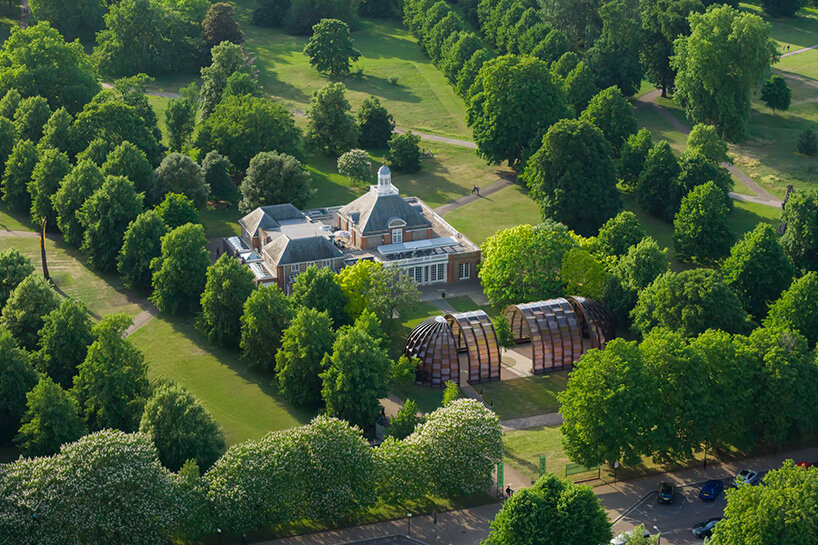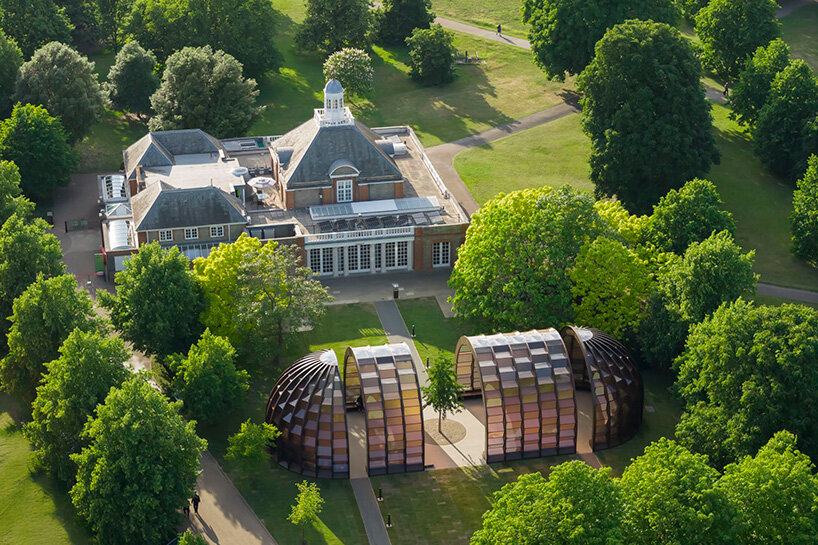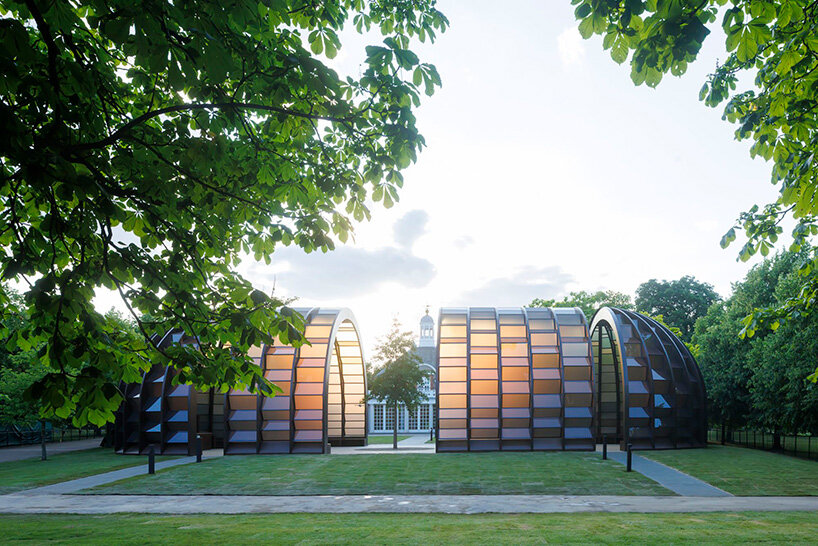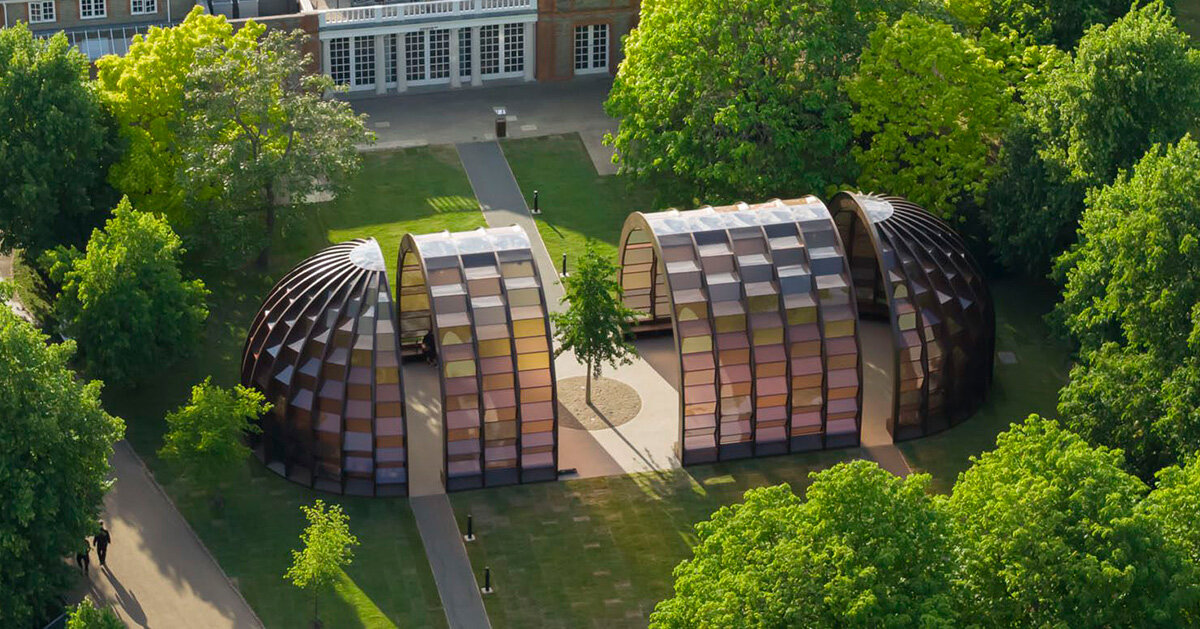london celebrates the serpentine pavilion opening
Opening to the public on June 6th and on view through October 26th, the 2025 Serpentine Pavilion by Marina Tabassum Architects is now complete in London’s Kensington Gardens. Marking the 25th anniversary of the Serpentine’s architectural program, the pavilion, titled A Capsule in Time, explores themes of impermanence, tactility, and light through a modular, timber-built structure designed to move, adapt, and ultimately disappear. Ahead of the opening, Marina Tabassum discusses with designboom the ideas that shaped this year’s design.‘The pavilion is called A Capsule in Time for many reasons,’ Tabassum tells us during our interview. ‘One is that I find the connection between architecture and time quite intriguing (…) pavilions have a temporality, which is not about time but about a moment—to embrace and enjoy it.’
Aligned with Serpentine South’s historic bell tower, the elongated north-south structure is composed of four translucent capsules that dapple the space with shifting light. Tabassum draws inspiration from the hydrologic landscapes of Bangladesh, where ‘land constantly moves—it’s a situation where sand beds form, water takes the land away, and then it recreates it.’ This ephemerality is echoed in the building’s material choices. The architect works entirely in wood for the first time, not only for its dry-construction potential and future reuse, but also for its local availability. ‘We haven’t worked entirely with wood before because wood is not a material in Bangladesh as such… but here, it made sense,’ she explains.

Serpentine Pavilion 2025 A Capsule in Time, designed by Marina Tabassum, Marina Tabassum Architects (MTA). exterior view. © Marina Tabassum Architects (MTA) | image by Iwan Baan, courtesy of Serpentine
inside ‘a capsule in time’, knowledge can be shared freely
A kinetic capsule embedded within the Serpentine Pavilion structure allows parts of the pavilion to shift and expand for public programming. ‘It’s a movable part of the structure that can shift and connect with another section to create a larger, covered space. That’s where the kinetic element comes in.’ Marina Tabassum notes. At the heart of the pavilion stands a ginkgo tree—a resilient species dating back to the Jurassic Period. ‘That tree gives life to the whole pavilion,’ the architect shares with designboom. ‘Even though it’s within a park and surrounded by nature, having a tree inside the pavilion really changes the atmosphere.’
Tabassum also sees the pavilion as a place of quiet resistance, an antidote to rising global censorship. Bookshelves built into the capsules host a curated selection of texts in Bengali literature, poetry, ecology, and identity. ‘Some of them are by writers whose works have been banned in Bangladesh,’ she reveals during our discussion. ‘In a time when many books are being banned and education is being questioned (…) the very notion of knowledge feels under threat. So it felt important to bring that idea of books and knowledge into the pavilion—a space where knowledge can be shared freely.’ Continue reading to explore our full conversation with Marina Tabassum, this year’s Serpentine Pavilion architect.

marking the 25th anniversary of the Serpentine’s architectural program | image by Iwan Baan, courtesy of Serpentine
interview with Marina Tabassum
designboom (DB): The Pavilion is called A Capsule in Time. What does that mean to you? What kind of histories, moments, or personal elements were you hoping to capture in this structure?
Marina Tabassum (MT): The pavilion is called A Capsule in Time for many reasons. One is that I find the connection between architecture and time quite intriguing. We started architecture as a discipline with the notion that it would last forever. It’s almost like a continuity—when you’re not there, your architecture remains. So it continues through time. Timelessness has also been a way of looking into architecture—how you can make your buildings timeless, which is about defying time. At the same time, pavilions have a temporality, which is not about time but about a moment—to embrace and enjoy it. In the case of the Serpentine, it’s there for a five-month period—nice summer days, a beautiful sunny day like today—and then it’s gone. But it has a presence in the virtual realm, which is our new reality.
Where I come from, in Bangladesh, we have this notion of land as temporal. Land constantly moves—it’s a hydrologic situation where sand beds form, water takes the land away, and then it recreates it. So this idea of land being eroded and re-emerging also carries temporality. Architecture is associated with that, because people keep moving their houses from one place to another. I also bring in my way of practice. I come from a place defined by temporality, but I’ve always been very interested in light. A nice summer day in London can be really beautiful. That light can be celebrated if we create a space that lets it through. Light is an important element in this design. It also connects to pavilion structures in Bangladesh—ones we create for weddings or religious occasions, called shamiyanas. These shamiyana structures are made of cloth and bring in beautiful light. Bringing that sense, that atmosphere, into this space was also very important to me.

exploring themes of impermanence, tactility, and light | image by Iwan Baan, courtesy of Serpentine
DB: The translucent facade creates a play of light and shadow. What was the process behind achieving that dappled effect? Was it intentional from the start, or something that evolved along the way?
MT: The decision to bring in this very sort of translucent light into the space was intentional. That was one of the design intents. From the very beginning, that’s what we wanted for that space. But achieving that effect was a process. Initially, we were thinking of using jute and laminated jute; we looked into it and did some research.
But jute is a material that is not fire-rated, so it would not be allowed in the pavilion.
Then we had to look for something we could source locally here in London. So we settled for polycarbonate sheet with a translucent film on it. That actually helped us bring in the quality of light that we wanted. The building is maybe initiated in the Serpentine in Kensington Gardens, but it has an afterlife. That means there will be a continuity of this building in another location. So it will be used again—it won’t go into a landfill. That’s why we opted for a material of that nature.
